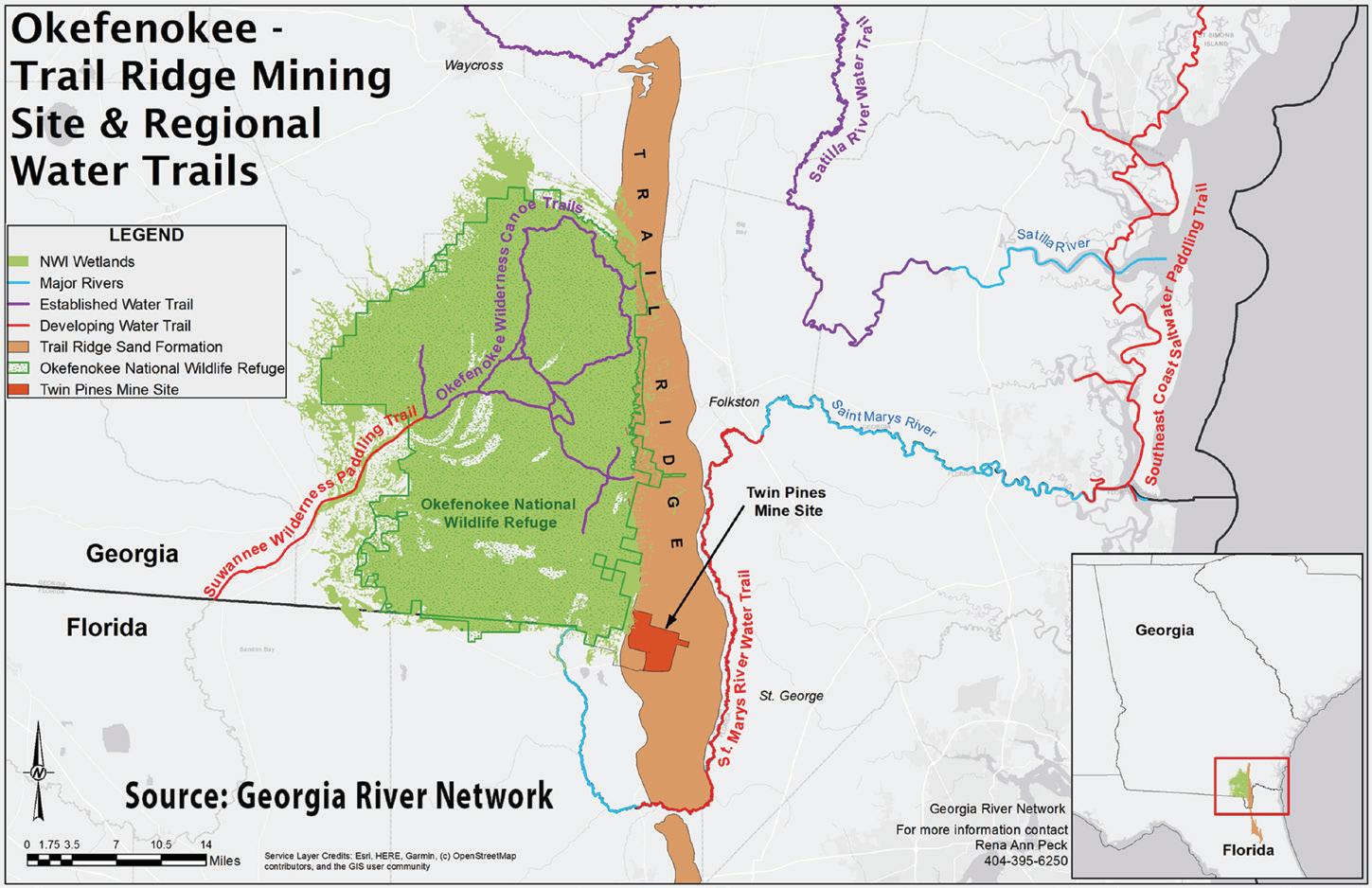
4 minute read
Sustainability
Georgia Officials to Determine Fate of Okefenokee
By Sally Bethea
Advertisement
The fate of the largest wildlife refuge east of the Mississippi River – a freshwater ecosystem of international importance, unparalleled biodiversity, and pristine wilderness – rests in the hands of Georgia officials.
Gov. Brian Kemp, his appointed Board of Natural Resources, and the state regulatory agency that they manage (Environmental Protection Division-EPD) will determine
whether or not the complex hydrology of the Okefenokee National Wildlife Refuge is compromised by invasive mining activities. Last year’s rollback of water protection laws by the Trump Administration resulted in the abrupt removal of any oversight or decisionmaking related to these proposed activities by federal agencies, including the Corps of Engineers, EPA and Fish and Wildlife Service.
The Okefenokee Swamp is a huge, shallow depression – nearly 12 times the size of Lake Lanier at 438,000 acres – that lies west, and immediately adjacent to, Trail Ridge: a mile-wide linear terrace of ancient origin. Running more than 100 miles across southeastern Georgia to northeastern Florida, it stands above the surrounding lowlands at an average height of a 16-story building. Once located many miles offshore when this area was covered by the sea during the last Ice Age, Trail Ridge is now about 45 miles from, and parallel to, the Atlantic Ocean.
Historically, the ridge formed a natural trail for Indians and early white settlers traveling through the coastal lowlands. Of critical importance to the Okefenokee’s structural integrity and function, Trail Ridge serves as the swamp’s eastern hydrological barrier. This natural blockade helps keep the slow-moving, blackwater system intact to support thousands of native plant, insect, and animal species – and attract the more than half a million humans who annually visit the refuge, contributing $64 million to local economies.
Since the middle of the last century, the titanium-bearing heavy mineral sands found in Trail Ridge have motivated companies to establish strip mining operations nearby. In the 1990s, DuPont attempted to place a mine on the edge of the refuge – igniting a struggle that spanned nearly a decade before the company abandoned its plans. Titanium is a strong, lightweight mineral used to make pigments that whiten paint, cosmetics, toothpaste and even Oreo cooking filling. In my September 2019 column, I described this battle and the successful outcome; passionate and strategic local activists and the federal government were able to protect the irreplaceable natural asset.
Two years ago, Twin Pines Minerals (TPM), an Alabama-based company, picked up the DuPont mantle and proposed to strip-mine another deposit of titanium to depths of up to 50 feet – deeper than the immediately adjacent Okefenokee depression – just outside the southeastern boundary of the refuge in Charlton County. This time around, as noted above, federal scientists and policy-makers will not play a role in officially reviewing TPM’s application and issuing permits, thanks to last year’s significant weakening of environmental laws. Over several decades, TPM could mine anywhere from 12,000 to 30,000 acres, starting with what the company calls a “demonstration project” on about 700 acres – once the Georgia EPD has considered and issued five environmental permits.
Prior to their removal from the review process, US Fish & Wildlife Service issued formal comments noting that the swamp “represents one of the very few selfcontained, naturally functioning wetlands in the world” – and that impacts from the TPM proposal are “not sufficiently known and whatever is done may be permanent.”
The USFWS report said the major unknown is the potential to drain the swamp, which would expose peat beds that would stoke wildfires. Intensity wildfires would pump enormous amounts of CO2 into the atmosphere and damage the timber economy. So, the mining is both a climate change threat and a threat to the timber economy that is the lifeblood of the area along with tourism.
Among the other unknowns: the hydrologic model presented by TPM to justify “negligible” impacts to the swamp has not been widely peer-reviewed; limited data was collected to use in the model; the maximum depth of future mining is uncertain; impacts to wildlife, federallylisted species, and recreation have not been thoroughly evaluated; and post-mining habitat restoration plans are incomplete – to name just a few.
While the “unknowns” regarding the damage this mining operation may impose on the Okefenokee are alarming, the “knowns” concerning the track record of TPM and its president Steve Ingle are highly disturbing. According to mining opponents, the company has a “long history of noncompliance, plain disregard for environmental protections… and making false statements to the federal government.”
In one instance, TPM submitted applications to state and federal authorities claiming it had the right to mine property near the swamp that it did not own or lease. In another case, Ingle serves as vice president of a power company that has been cited for air pollution, odor, noise and water violations at two wood-burning plants in northeast Georgia; railroad ties treated with creosote were burned at these sites, until the activity was recently outlawed. Citizens claim that Ingle’s company came to their communities “under false pretenses and misinformation.”
The Georgia EPD has said that TPM’s five environmental permit applications will undergo a comprehensive analysis and that public hearings will be held. While this is a positive sign – as long as the studies are independent and extensive – TPM has not been shy about engaging dozens of lobbyists
Above the Water Line
Sally Bethea
Sally Bethea is the retired executive director of Chattahoochee Riverkeeper and an environmental and sustainability advocate.











